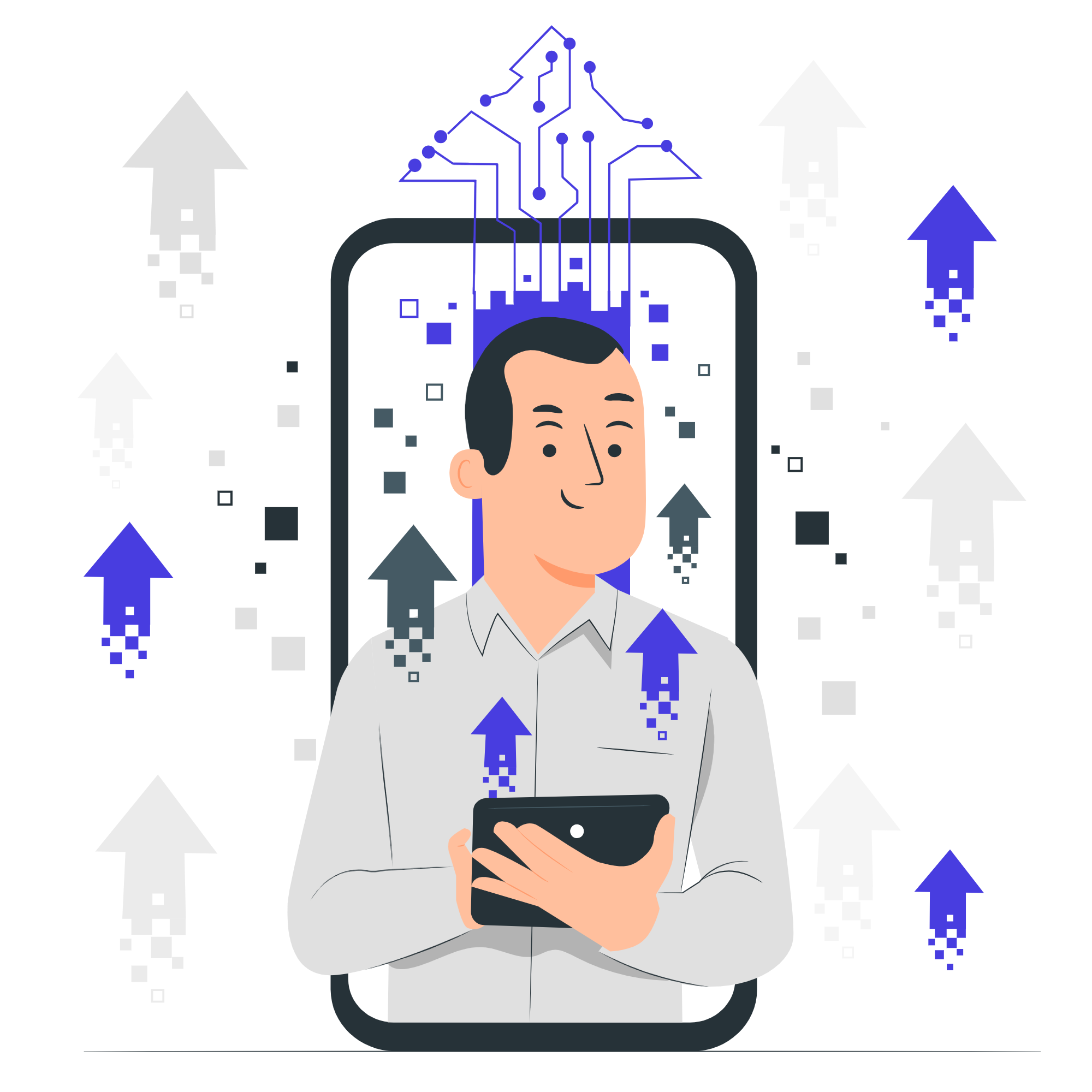Digital transformation is a super upgrade of business with an eye to modern realities. Business processes, business models and corporate culture of the company are being improved. That is, the essence of the activity remains the same, but digital technologies are used to achieve the goal.
Why is it needed? Such changes will inevitably affect everyone, since everything changes, improves, and is supplemented. If you resist this, you will remain on the margins of the civilized world. The issue is especially acute for businessmen who worked well yesterday, but today are already lagging behind progress.
Digital transformation in business is the widespread introduction of digital technologies into an existing production model or a newly created one. This definition applies not only to the manufacturing industry, but also to other areas of public life. In particular, public administration and education are already successfully mastering new models of digital transformation.
Why is it necessary to complicate processes that have been well-established for years? To bring the company’s business activities in line with the rapidly changing requirements of modern reality. In other words, with the help of digital transformation, you can remain competitive in new conditions and make the right decisions even with significantly changing external influences.
When a company begins a transformation process, this entails the creation of new positions that provide for the performance of professional responsibilities. This is especially true for the field of information technology. For example, CIO, Digital Transformation Leader, Chief Digital Officer, CTO, Data Scientist.
Digital transformation of business processes cannot be achieved without digitalization. It would seem that they are almost the same concepts, but in fact they are significantly different.
Digitalization (digitalization) is understood as the comprehensive penetration of the latest digital technologies into all spheres of production and life. This is the next logical step after data digitization, that is, transferring all information into digital format, as well as improving its processing.
From a practical point of view, this is very convenient, since the company gets rid of paperwork, which takes up quite a lot of working time. The digitalization process is accompanied by the emergence or modernization of the IT department.
Digital transformation lies not only in the introduction of new technologies into production, but also in the approach to business culture. This process affects a large number of areas: from managing corporate culture and business processes to creating new forms of working with clients.
Digital transformation is a change in existing business processes through the introduction of modern digital technologies and data-driven approaches, occurring due to the increased impact of competition.
In modern business conditions, most companies have access to huge amounts of information that can be converted into ideas useful for development, and also used to make informed and prompt decisions.
Data Driven is an approach to managing a company’s business processes, based only on the analysis of actual data. With its help, you can most accurately assess the rapidly changing needs of potential clients, make personal offers and develop service areas.
Using the Data Driven approach, we gain an understanding of which goods and services will be most in demand even before demand reaches its maximum value. A key condition for the successful functioning of a business in a modern economy is the massive use of digital technologies to find technologically advanced ways to enter products into markets.
Digital technologies are designed to help employees perform their core responsibilities most effectively. Important departments of the company, such as finance, accounting, HR, will be able to almost completely automate the execution of basic tasks. For example, processing customer data or payroll.
Networking and digital collaboration make it much easier for different departments and groups within a company to interact. Also, using the digital transformation process, you can set up employees to work remotely, which is especially important during the coronavirus pandemic.
Any thriving business bases its functioning on the development of normal relationships with clients. And digital tools will help in accomplishing this task.
Digital business transformation works to improve brand image through more intensive work with consumers at various stages: from expedited complaint resolution to activation of sales and promotions. All this leads to an increase in the efficiency of the enterprise.
Many companies depend on each other. To attract consumers to their product, they have to interact with their partners: suppliers of raw materials and semi-finished products, contractors, consultants, etc. Of course, communication with them can also be carried out using paper document flow, which requires a lot of time and eliminates operational interaction.
With the help of digital technologies, this process is greatly simplified, as it becomes faster, more accurate and more transparent. Optimizing internal communication between all stakeholders saves time, resources and strengthens mutually beneficial relationships.
Today, businesses are in great demand for IT services of a hybrid nature, which expand opportunities for networking and improve the quality of service. This doesn’t just apply to the ease of use of apps for employees and their customers. The functioning of on-demand services is not possible without clear interaction with IT personnel and relevant tools.
Modern companies are constantly under pressure from growing competition and increasing demands from consumers every day. The main goal of digital transformation of management is to help the manager and departments of the company increase efficiency and competitiveness for each operational activity. Leading technologies have a central role in the transformation process, but business processes, development models, corporate culture and ethics, and readiness for future changes should not be considered mediocre.
Any planning in the field of digital transformation and digital development of a company should include three main areas.
The result of business process transformation is clearly visible in business operations due to improved management of operational flows. For example, mastering a cloud-based digital supply chain management system will help reduce downtime, optimize the production process and, as a result, increase profitability.
If business process transformation involves changing the work process, then the main focus of business model transformation is the process of creating value in a specific area. In physical terms, companies are using digital transformation to change classic business models.
For example, in the automotive industry, digital technologies can help centralize and automate vehicle subscription business models and invoicing mechanisms. Currently, an increasing number of consumers are inclined to purchase a car subscription instead of a traditional purchase. This is facilitated by rapidly changing demand and ongoing cultural changes in society.
Digital transformation is only successful when it aligns with the company’s culture and values. If an employee does not believe in the values of the corporate culture, then this negatively affects his work productivity, leads to a loss of initiative and, accordingly, reduces well-being.
Slow implementation of digital technology with long interruptions and a lack of an optimistic attitude in most cases lead to the risk of missed opportunities, strengthening the position of competitors, and reducing the profitability of the enterprise and the value of the brand.
Effective transformation of corporate culture is impossible without open discussions and collaboration initiated by the leadership team. It is important that people know and understand the impact the transformation process will have on roles and work processes, and why management believes that working towards the future will ultimately yield positive results.
An employee who is responsible for digital transformation at an enterprise must clearly know and understand the need for it in the current conditions. According to a study by 451 Research, about 60% of organizations that have embarked on the path of digitalization do not have a final development strategy. And this, according to experts, will not lead to anything good.
Without a clear vision and understanding of strategy, there is no chance of successfully carrying out digital transformation of an enterprise of any size.
When carrying out transformations, it is necessary to take into account that this is not a quick process that requires a serious and orderly approach. After the successful implementation of all stages of the organization’s transformation, one cannot stop there; it is necessary to continue development, taking into account new technologies and developments.
The basis of digital transformation is the development of modern technologies, which are characterized by the following feature – each subsequent development is more focused on the needs of the client, and accordingly, it becomes more convenient and easier to use them.
When such conditions arise, the issue of motivation of top management and employees responsible for the ongoing transformations becomes important. Each member of the digital transformation team must understand the purpose of the upcoming changes and understand the importance of the fact that the path of digitalization is not a luxury, but a real necessity in today’s conditions.
Mastering digitalization technology is only part of the entire transformation process. According to the owners of the enterprise and those responsible for implementing changes, the most difficult thing is to adapt the team to the updated business processes. The transformation will affect every employee of the company, so it is necessary to organize events as a result of which people will be able to master new processes and technologies.
One of these events may be master classes and trainings, during which employees learn the skills necessary to work in the new realities. Modern technologies are also assistants in the adaptation period. For example, with the help of UX design, the interface of various programs can be made intuitive, and the use of artificial intelligence will speed up data processing and make the optimal decision.
A team of professionals, highly motivated employees, a detailed strategy – these are all the elements without which successful business transformation is impossible. But a digitalization system should be added to this list, including special tools that allow for qualitative changes.
Experts recommend that those companies that decide to carry out transformations begin the changes with the four steps listed below. It will also be important to have ongoing communication with the software provider to help develop your digital transformation strategy and roadmap. Programmers will also help you navigate in choosing the best solution that meets the needs of the company.
To predict the successful launch of the transformation, a list of processes within the company that have a high operational priority should be compiled so that they are easier to transform.
You shouldn’t plan to run a marathon if you don’t have the proper preparation. The advantage of a digital transformation program is that it does not need to be planned and implemented in a short time frame. Intelligent technologies are created for gradual development, scaling and further integration.
The advantages of using intelligent technologies are their high ability to scale, as well as quickly adapt and change configuration. A well-designed transformation roadmap should allow for flexibility and growth. It is from drawing up a route map that it is necessary to begin the implementation of the project.
In the process of transformation, not only technology is improved, but also various competencies are developed in people. Following these first steps is essential for successful change.
With the help of intelligent technologies, it is possible to significantly reduce the number of repetitive tasks of the same type, increase motivation and, accordingly, the involvement of employees, which will result in effective cooperation.
However, it should be kept in mind that all these benefits will only be fully realized if these technologies are used by every employee. There is no need to set specific deadlines for completing tasks for the department. It is important to have feedback, to listen to all ideas, suggestions and concerns.

